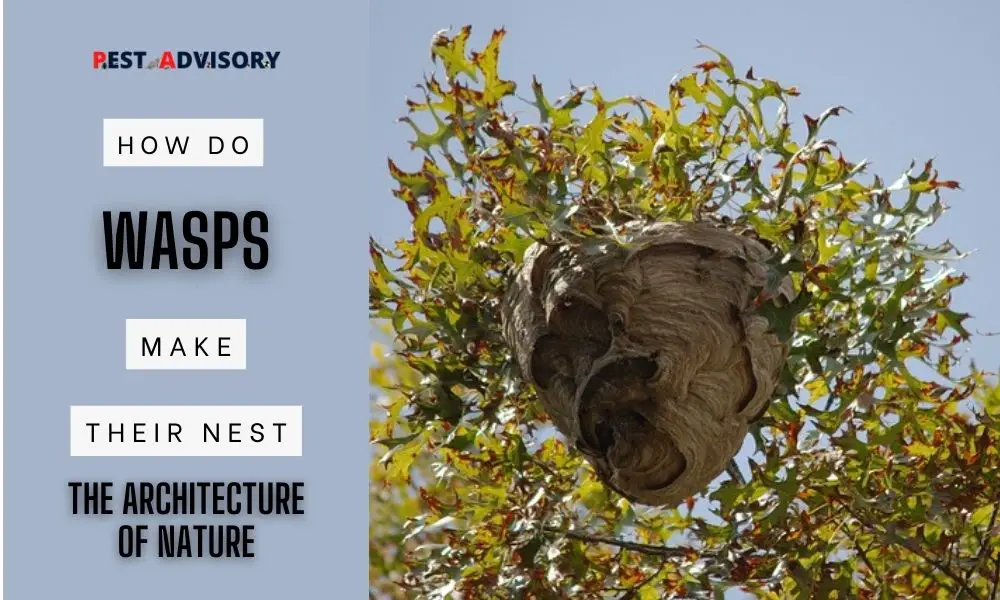Have you ever come across a wasp nest and marveled at its intricate construction? From chewed-up plant fibers to mud walls, wasps use a variety of materials and techniques to create their homes.
But how exactly do these tiny creatures build such complex structures?
In this post, we’ll delve into the intriguing world of wasp nest construction, looking at the various stages involved and the role that social behavior plays in the process.
Important Note: If you're tired of pests and want a reliable solution, then you should definitely consider seeking help from a professional pest control company. DIY solutions can be effective, but if you're dealing with a significant pest infestation, you don't want to rely solely on DIY methods. Pest control companies typically don't charge huge fees. You can fill out this form to receive free quotes from the top local pest control companies, and compare the quotes and see for yourself. Then, finally, your pest problems will be eliminated for good.
Join us as we dive deeper into nature’s architecture and the remarkable ways in which wasps construct their homes, whether you’re a fan of nature or just interested in how the natural world functions.
Can Wasps Build Their Nest?
Yes, wasps can build their own nests. They construct their homes using a variety of materials, such as chewed-up plant fibers, mud, or even saliva.
The process of nest building typically involves multiple stages, including the collection of materials, the arrangement of cells, and the incorporation of protective features.
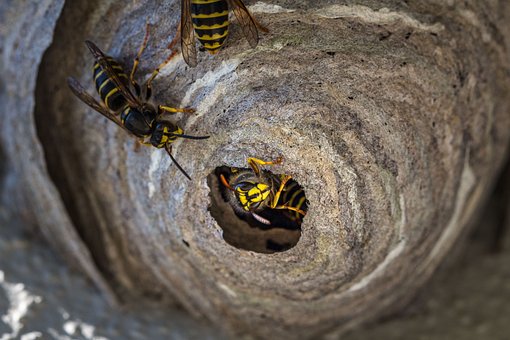
How do Wasps Make their Nest
Wasps are social bugs that construct their nests from materials that resemble paper. They do this by chewing wood and combining it with saliva to produce the material.
Here is a step-by-step explanation of how wasps construct their nests:
Select a suitable location
When beginning the process of building their nest, queen wasps will carefully select a location that provides a suitable environment for their colony to thrive.
This may take into account factors like shelter from the wind and rain, safety from predators, and simplicity of access to food supplies.
Once a suitable site is found, the queen wasp will begin constructing the initial framework of the nest.
Gather wood fibers
After selecting a suitable location, the queen wasp will begin to gather materials for the nest.
Typically, this involves collecting wood fibers, which are scraped off of various structures using the wasp’s mandibles.
These fibers will eventually be used to construct the outer layers of the nest.
Mix the wood fibers with saliva
Once the queen wasp has gathered enough wood fibers, she chews them and mixes them with her saliva to create a pliable, paper-like paste.
The saliva helps to break down the wood fibers, making them easier to mold and shape into the various components of the nest.
This paste will eventually harden into the walls of the nest as it dries.
Build the petiole
As the queen wasp begins to build the nest, one of the first structures she creates is the petiole.
This is a stalk-like structure that will eventually support the entire nest.
The petiole is constructed using a wood fiber and saliva paste and is carefully crafted to provide a strong and stable foundation for the rest of the nest.
Create the cells
After constructing the petiole, the queen wasp shapes the paper-like paste into individual cells for eggs and larvae.
She carefully lays an egg in each cell and seals it shut using the same paste.
These cells provide a safe and protected environment for the developing eggs and larvae, as well as a secure location for storing food.
Add layers
As the larvae grow and develop, the queen wasp continues to add more cells to the nest.
These cells are built around the previous layer, creating a dome-shaped structure.
The wasp uses the same wood fiber and saliva paste to create each layer, gradually building up the nest and expanding it to accommodate the growing colony.
Create outer layer
Once the nest has reached a certain size, the queen wasp will create an outer layer to protect the inner cells.
This layer is made from a thicker paper-like paste, which is stronger and more durable than the paste used to create the inner cells.
The outer layer provides additional protection against the elements and potential predators.
Finish the nest
After constructing the outer layer, the queen wasp will add any final touches or details to the nest, such as additional decorations or reinforcement.
Once the nest has been constructed, it can be hung from a variety of places, including a tree branch, a bush, or even inside a building’s eave.
The completed nest provides a safe and secure environment for the wasp colony to thrive.
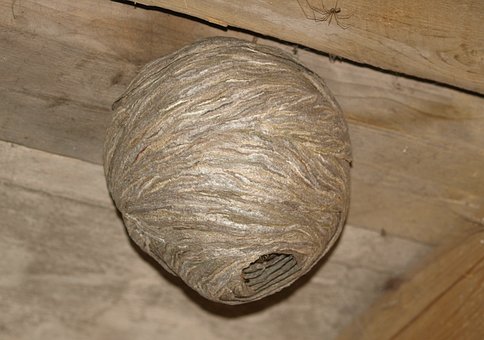
What are the different types of wasp nests?
There are several different types of wasp nests, which are built by different species of wasps.
Here are the most common types of wasp nests:
Paper Wasp Nests
These nests are usually built under eaves, on branches, or in other sheltered locations. They are typically shaped like an upside-down umbrella and made of paper-like material.
Yellow Jacket Wasp Nests
Yellowjacket nests are usually located underground or in cavities, such as hollow trees or walls. They are made of paper-like material and have a distinctive layered structure.
Mud Dauber Wasp Nests
These nests are made of mud and are often found in sheltered areas, such as under eaves, on walls, or in attics.
Bald-faced Hornet Nests
These nests can be identified by their size and unusual teardrop form and are typically found high up in trees or on buildings. They feature a paper-like outer layer that shields the interior cells, and they are formed of a material that resembles paper.
European Hornet Nests
The nests of European hornets are typically located in tree cavities, inside walls or attics, or under eaves. They are made of a papery material that is similar to that of yellow jacket nests.
Cicada Killer Wasp Nests
These nests are built in the ground and can be identified by the large piles of soil around the entrance hole. They are usually solitary and do not form large colonies like other wasp species.
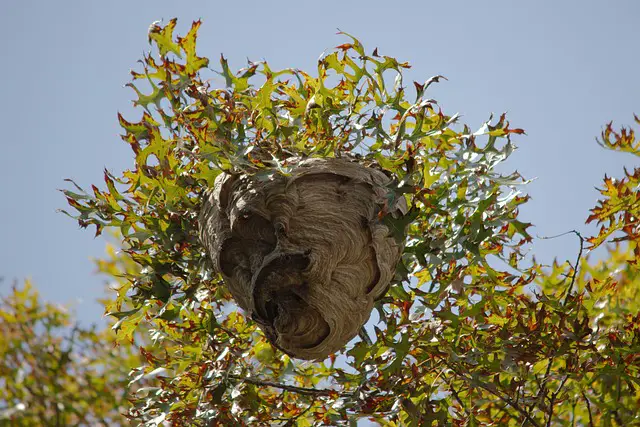
Frequently Asked Questions
How long does it take a wasp to build a nest?
The time it takes for a wasp to build its nest varies based on the species and colony size.
Typically, a fully developed wasp nest can take about 4-6 months to complete. The queen wasp starts the process in the spring by building a petiole and single cell, gradually adding more cells as she lays eggs.
The nest grows throughout spring and summer until it reaches full size, taking several months to complete.
Will wasps return to a destroyed nest?
It is highly unlikely that wasps would return to a destroyed nest – whether it was destroyed by humans, animals, or natural causes.
Once the nest has been destroyed, the pheromones that attracted the wasps to the area scents that lured the wasps to the area are no longer present once the nest has been destroyed, and the nest itself is no longer a feasible location for the wasps to live.
However, if the queen wasp survived the nest destruction and is still present in the region, she may attempt to build a new nest nearby.
What do wasps do in their nest all day?
The queen wasp is responsible for laying eggs and reproducing. She spends most of her time in the nest, laying eggs and being tended to by the worker wasps.
The drones are male wasps whose primary role is to mate with the new queens produced by the colony at the end of the season. They do not play any role in nest-building or caring for the young.
The workers are non-reproductive female wasps, who take care of all the tasks inside and outside the nest. Their duties include constructing and maintaining the nest, caring for the young, and foraging for food.
What materials do wasps use to build their nests?
Wasps use various materials to construct their nests, but the most common material is paper pulp.
Paper pulp is made by chewing and mixing together wood fibers or plant material with saliva.
The mixture of chewed wood fibers and saliva creates a papery material that the wasps use to build the nest.
Do wasps reuse their old nests?
No, wasps do not reuse their old nests. Once the wasps have finished using a nest, they abandon it and do not return to it again.
Even if the old nest is still intact and in good condition, wasps will not reuse it. Instead, they build new nests each year.
This is because wasp nests are built of fragile materials such as paper pulp, which disintegrate gradually due to exposure to weather and other environmental variables.
Additionally, wasps produce pheromones that attract them to specific nesting sites. Once another nest has been formed, the wasps will stay in that place as long as it is suitable.
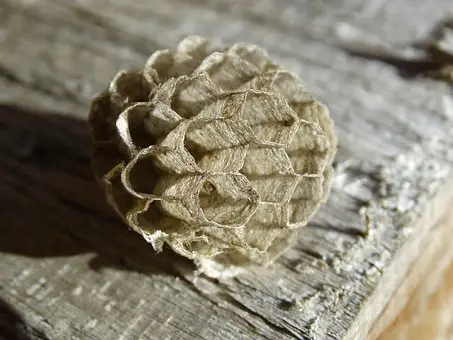
Conclusion
The process of how wasps build their nests is a fascinating example of nature’s architectural wonders.
From selecting a suitable site to gathering wood fibers and constructing individual cells, the queen of wasp plays a critical role in creating a safe and secure environment for her colony.
These small insects are able to make intricate and enduring structures that allow them to live in the natural world through careful construction and attention to detail.
Identifying the nest is the initial step in eliminating wasps, as it enables you to strategize your attack as you’ll get to know whether you’re dealing with hornets nest or wasp nest.

